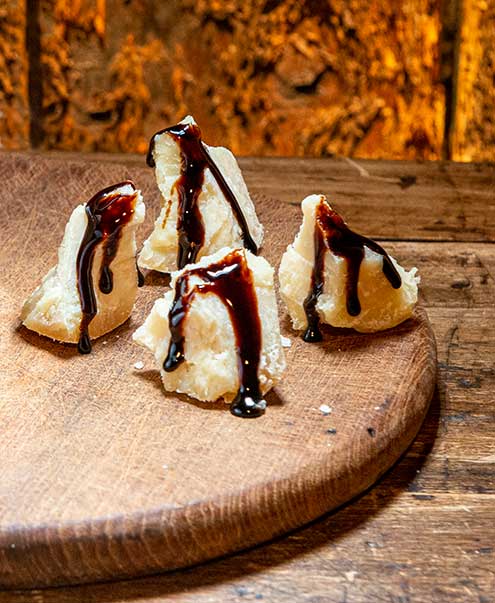Vinegar
How Fattoria La Vialla’s vinegar and balsamic vinegar are created
Vinegar is used on salads all over the world, in the famous vinaigrette, and in Italy it is also produced in the prestigious balsamic version. Let’s take a look at how vinegar is made. It’s an acidic liquid obtained from fruit, such as apples, pears, pomegranates, soy, or from other products such as cider, mead, rice, beer – in our case, from wine. Transformation comes about thanks to the action of bacteria – of the genus Acetobacter – that, in the presence of air and water, oxidise the ethanol (or ethyl alcohol) contained in the wine, transforming it into acetic acid. Like the majority of products created in the countryside, the origins of which date back to the dawn of time, vinegar is a “recycled” product: it sometimes used to occur – and still does – that grapes vinified in “precarious” conditions, or inexpert hands, were exposed to too much air or reached an overly high temperature, triggering processes of acetification. It was common practice for leftover wine to be added to the vinegar barrel, which contained “the mother”: a darker, gelatinous mass composed of acetic bacteria and yeasts. Naturally, in farming households nothing was thrown away. Even wine with slight imperfections was drunk. But what remained at the end of the year, was used to replenish the vinegar barrel.
 A tempting appetizer – Balsamic Vinegar & Pecorino Riserva
A tempting appetizer – Balsamic Vinegar & Pecorino Riserva
Over the centuries – region by region – a vinegar culture has taken root, assuming very different forms, importance and contours, but revolving around one common aspect: the intense, decidedly acidic taste, used in dressings, for preserves, and sweet and sour recipes. Here in Tuscany we traditionally use wooden barrels, or small oak barriques, which have exhausted their ability for ageing wine. The grapes harvested – typical to Chianti (Sangiovese, Canaiolo, Trebbiano, Malvasia) – that have thinner skins and a lower alcohol content, are vinified separately to make vinegar and put into these recycled barrels to mature, for varying periods of time. At La Vialla we produce traditional red wine vinegar using grapes from organic and biodynamic agriculture, with lower sugar content and not completely ripe. It rests for 6-12 months in wooden barrels that have already been used for five years to age the Fattoria’s red wines.
In the province of Modena (Emilia Romagna) an out and out balsamic vinegar cult has developed. Over the centuries noblemen and, later on, also farmers and various other people, developed an extremely long ageing process (at least 12 months according to the regulations, but more commonly over 20) for grape must, which is cooked and then aged in barrels of various sizes and types of wood. A set of small “Caratelli” barrels is used, each containing from 20 to 200 litres and made of a different wood (from cherry to oak), in which the precious liquid ages – concentrated through evaporation – and is poured from one to the next until reaching the smallest, as it gradually decreases in volume.